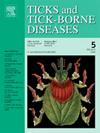下载PDF
{"title":"Description of Rhipicephalus hibericus sp. nov. (Ixodoidea: Ixodidae), a species of the Rhipicephalus sanguineus group in southwestern Europe","authors":"Javier Millán , Ruth Rodríguez-Pastor , Agustín Estrada-Peña","doi":"10.1016/j.ttbdis.2024.102340","DOIUrl":null,"url":null,"abstract":"<div><p>We describe all the life stages of <em>Rhipicephalus hibericus</em> n. sp., provide the types, and present molecular support for a new species of the <em>Rhipicephalus sanguineus</em> sensu lato group, present in southwestern Europe, that has been historically confused with <em>Rhipicephalus turanicus</em> Pomerantzev, 1940. A new name is proposed for this taxon because it was impossible to ascribe to types of already described species in the group, deposited for more than 100 years in natural history institutions. The males have a dorsum showing deep and coarse punctations (absent in <em>Rhipicephalus sanguineus</em> sensu stricto) and adanal plates with large punctations (absent in <em>R. sanguineus</em> s.s.); the tail of the spiracular plate is as wide as the closest festoon (half the width in <em>R. sanguineus</em> s.s.). Females have large punctations in dorsal fields, a wide spiracular plate, and a “V” shaped genital opening; such a combination of characters cannot be found in other species of the group. Immatures are described from specimens collected on hosts (Rodentia and Eulipotyphla). Both larvae and nymphs are markedly smaller than <em>R. sanguineus</em> s.s. Nymphs display long, backward-projected auriculae; larvae are almost half the size of <em>R. sanguineus</em> s.s. The new species can hybridize with <em>R. sanguineus</em> s.s. in laboratory colonies producing an unfertile F2, laying brown and dry eggs that did not hatch. Phylogenetic analysis of partial <em>coxI</em> gene sequences placed <em>R. hibericus</em> in a well-supported clade with other sequences of <em>R. sanguineus</em> s.l. from Portugal, as a sister clade of <em>R. sanguineus</em> s.s. The new species does not belong to the <em>R. turanicus</em> group of species. Both <em>12S</em> and <em>16S</em> partial gene sequences were not as precise in the correct phylogenetic placement of <em>R. hibericus</em>, in part probably due to the existence of erroneously identified sequences in GenBank©. This description, together with the previous reinstatement of <em>Rhipicephalus secundus</em> and <em>Rhipicephalus rutilus</em>, and the description of the neotypes of <em>R. sanguineus</em> s.s. should help researchers to adequately identify their collections. Our findings demonstrate that <em>R. turanicus</em> is absent in southwestern Europe. Old collections should be re-examined to provide the actual range of the new species.</p></div>","PeriodicalId":49320,"journal":{"name":"Ticks and Tick-borne Diseases","volume":"15 4","pages":"Article 102340"},"PeriodicalIF":3.1000,"publicationDate":"2024-04-06","publicationTypes":"Journal Article","fieldsOfStudy":null,"isOpenAccess":false,"openAccessPdf":"https://www.sciencedirect.com/science/article/pii/S1877959X24000335/pdfft?md5=773b5280ea7bd8e4f38c8e9c62c63bd0&pid=1-s2.0-S1877959X24000335-main.pdf","citationCount":"0","resultStr":null,"platform":"Semanticscholar","paperid":null,"PeriodicalName":"Ticks and Tick-borne Diseases","FirstCategoryId":"3","ListUrlMain":"https://www.sciencedirect.com/science/article/pii/S1877959X24000335","RegionNum":2,"RegionCategory":"医学","ArticlePicture":[],"TitleCN":null,"AbstractTextCN":null,"PMCID":null,"EPubDate":"","PubModel":"","JCR":"Q2","JCRName":"INFECTIOUS DISEASES","Score":null,"Total":0}
引用次数: 0
引用
批量引用
Abstract
We describe all the life stages of Rhipicephalus hibericus n. sp., provide the types, and present molecular support for a new species of the Rhipicephalus sanguineus sensu lato group, present in southwestern Europe, that has been historically confused with Rhipicephalus turanicus Pomerantzev, 1940. A new name is proposed for this taxon because it was impossible to ascribe to types of already described species in the group, deposited for more than 100 years in natural history institutions. The males have a dorsum showing deep and coarse punctations (absent in Rhipicephalus sanguineus sensu stricto) and adanal plates with large punctations (absent in R. sanguineus s.s.); the tail of the spiracular plate is as wide as the closest festoon (half the width in R. sanguineus s.s.). Females have large punctations in dorsal fields, a wide spiracular plate, and a “V” shaped genital opening; such a combination of characters cannot be found in other species of the group. Immatures are described from specimens collected on hosts (Rodentia and Eulipotyphla). Both larvae and nymphs are markedly smaller than R. sanguineus s.s. Nymphs display long, backward-projected auriculae; larvae are almost half the size of R. sanguineus s.s. The new species can hybridize with R. sanguineus s.s. in laboratory colonies producing an unfertile F2, laying brown and dry eggs that did not hatch. Phylogenetic analysis of partial coxI gene sequences placed R. hibericus in a well-supported clade with other sequences of R. sanguineus s.l. from Portugal, as a sister clade of R. sanguineus s.s. The new species does not belong to the R. turanicus group of species. Both 12S and 16S partial gene sequences were not as precise in the correct phylogenetic placement of R. hibericus , in part probably due to the existence of erroneously identified sequences in GenBank©. This description, together with the previous reinstatement of Rhipicephalus secundus and Rhipicephalus rutilus , and the description of the neotypes of R. sanguineus s.s. should help researchers to adequately identify their collections. Our findings demonstrate that R. turanicus is absent in southwestern Europe. Old collections should be re-examined to provide the actual range of the new species.
描述 Rhipicephalus hibericus sp.
我们描述了Rhipicephalus hibericus n. sp.的所有生命阶段,提供了模式,并为Rhipicephalus sanguineus sensu lato类群的一个新种提供了分子支持,该种分布于欧洲西南部,历史上曾与Rhipicephalus turanicus Pomerantzev, 1940混淆。由于无法将该分类群中已描述的物种类型归属于该分类群,因此为该分类群提出了一个新名称,这些物种已在自然历史机构中保存了 100 多年。雄性背部有深而粗的点状突起(严格意义上的 Rhipicephalus sanguineus 没有),肛门板上有大的点状突起(R. sanguineus s.s.没有);螺旋板的尾部与最接近的花冠一样宽(R. sanguineus s.s.宽度的一半)。雌性背田有大的点状突起、宽大的螺纹板和 "V "形的生殖器开口;这类物种中找不到这样的特征组合。幼虫的描述来自在寄主(啮齿类动物和鳗鲡)上采集的标本。幼虫和若虫的体型都明显小于胭脂虫。若虫的耳廓较长,向后凸出;幼虫的体型几乎是胭脂虫的一半。新种可与胭脂虫在实验室群落中杂交,产生不育的 F2,产棕色干卵,但不孵化。通过对部分 coxI 基因序列进行系统进化分析,将 R. hibericus 与来自葡萄牙的其他 R. sanguineus s.l. 序列组成一个支持良好的支系,成为 R. sanguineus s.s. 的姊妹支系。12S 和 16S 的部分基因序列都不能精确地确定 R. hibericus 的正确系统发育位置,部分原因可能是 GenBank© 中存在错误的鉴定序列。这一描述,加上之前对 Rhipicephalus secundus 和 Rhipicephalus rutilus 的恢复,以及对 R. sanguineus s.s. 的新模式的描述,应能帮助研究人员充分鉴定他们的收藏。我们的研究结果表明,欧洲西南部不存在 R. turanicus。应重新检查旧的采集物,以提供新物种的实际分布范围。
本文章由计算机程序翻译,如有差异,请以英文原文为准。

 求助内容:
求助内容: 应助结果提醒方式:
应助结果提醒方式:


